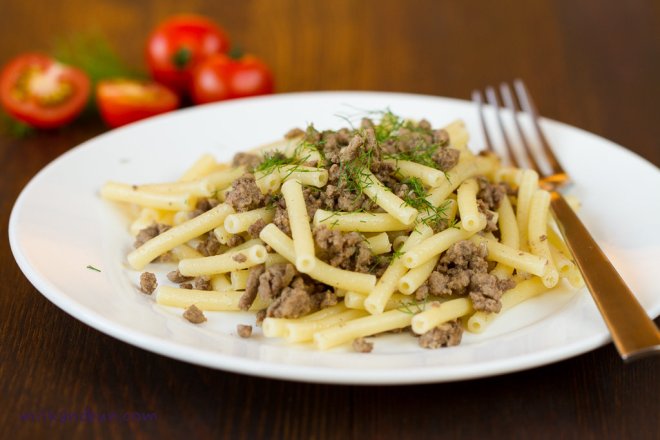Flot means fleet in Russian. This simple dish consists of macaroni mixed with fried minced meat. In 17-18th centuries, in Russia similar dishes were quite popular among travelers and especially sailors; that no-fridge time meat was salted-cured and kept in barrels, thus seamen could cut a piece of the meat anytime, fry it and mix with some boiled macaroni. The dish became popular again during World War, but instead of fresh or frozen meat was used tushonka – canned stewed meat (usually fatty pork or beef), which was always on hand, and it could be stored up for years without loosing its nutritional value. Post-war period was also hard time for Russia, so such not expensive and nourishing dish didn’t get out of use. Nowadays, ‘macaroni a la flot’ are still widely-cooked and well-known dish; normally pasta tubes are used for macaroni, which mixed with fried minced meat (it can be pork, beef or mixture), onions and sometimes tomato paste or fresh chopped tomatoes.
Macaroni a la flot
- In a deep pan, melt the butter with oil on a medium heat, add onion and fry for 4-5 minutes. Add meat and use wooden or stiff spatula to break it up into small pieces. Season to taste. Ensure you stir the meat regularly so it doesn’t stick to the pan and to make sure it cook evenly. The meat is cooked when it shows no signs of pink.
- Meanwhile, put pasta into a large pot of boiling water. Be sure to add plenty of salt to the water. Cook the macaroni according to package instruction.
- Add 3-4 Tbsp of pasta-boiling water to the meat, mix well.
- When the pasta is al dente, drain it and add to the pan with meat. Give it a good stir.
- Serve warm. Sprinkle with chopped parsley or fennel, if desired.
Enjoy!














Sounds like a wonderfully delicious and simple meal to pull together for a weeknight dinner!
Thank you, Heather! It’s very simple but also very quick and tasty dish to make; sometimes it’s useful! 😀
Oh, this brings back so many memories. As a child, my mom used to send me to a Russian-speaking camp in France, and the cook made this at least once or twice a week! I LOVED it then, and I have no doubts I’d love it now!
Glad to hear from you, Darya! Actually, I almost forgot about this dish until I bought this short tube macaroni. 😀 And what was the pasta in that camp? spaghetti?
No it wasn’t spaghetti! It was a short kind of pasta, but not macaroni. I am not sure which kind… my memories are not accurate enough!
Anyway, this dish reminds my childhood, too.:)
So simple, yet so flavorful. Love the addition of fennel as a garnish 🙂
Thank you, Loretta! Fennel adds a nice and fresh touch 🙂
A new one on me. It looks lovely in it’s simplicity.
It is! 🙂 Thanks, Conor!
I love a quick meal like this, simple and delicious.
Thank you for the comment, Suzanne! It’s type of meal when you don’t want to spend much time in the kitchen. 🙂
Oh, yea. I’ll be writing you about how this went! I LOVE pasta, and this just looks soooo easy!
I adore any pasta, too! 😀 But don’t expect much, it’s really very simple dish! 🙂 You may add chopped tomato or grated carrot..
I would never have thought of those options. Being an American, the first thing that comes to my mind when I think tubular type pasta is cheese! LOL! Some stereotypes do exist based on a general reality!!
Ooops, I think I wrote incorrectly – I meant add carrot to the meat, to saute it along with meat.. 🙂
But cheese goes perfect with pasta! 😉
I always love the history you give with your meals. It puts them in context and really helps me to appreciate how they came about and thus the flavors and reasons behind them. So cool. This is one dish my husband could actually make and enjoy. He’s good at various versions of chicken too, but this is kind of something like what he makes once a week.
Thank you for your comment, dearest Amanda! It’s very popular dish in Russia; almost everyone could prepare it. 🙂
I grew up with tube long macaronis too. In Iran, all pastas are called macaroni. 🙂 Lately, I have been making macaroni meat sauce without tomato or tomato paste. I did not know that it can be called macaroni a la flot. I love it, simple and delectable.
Oh, we do the same in Russia- all pasta call macaroni! 😀
Awh, you brought back some funny and wonderful memories to me 🙂
Happy to hear it, Yana! 😉
Simple and with a cool name – thanks for introducing me to it 😀
Cheers
Choc Chip Uru
Always happy to see you, Uru! Thanks for commenting! 🙂
Great history behind the dish. So simple yet, it looks so yummy!
Thank you! it’s such a well-known dish in Russia, that I had to write about it! 🙂
Loved the bit of history – all I know about meat on board of Russian ships comes for ‘Battleship Potemkin’, so your post has been able to reassure me a little about the health and safety standards on board 😉
Wow, Ginger! I almost forgot about Potemkin.. you know a lot! 😉
Not really, I just have a weakness for old films 😉
What an interesting introduction! And I like the dish – it looks perfect for a simple mid-week meal 🙂
Exactly, Trixy, it’s super-quick recipe for the mid-week! Thanks for commenting! 🙂
I love macaroni, it’s such an easy and quick dish to make for dinner on busy days. I’ll definitely have to give this recipe a try!
Totally agree with you, Pamela! Quick and nourishing – perfect for busy days. 🙂
In Restaurant:
-What would you like to eat?
-Mm.. I like seafood..
-Fish..? Prawns..?
-Macaroni a la flot please..
-😳😳😳
©
😀
Interesting history for your macaroni dish.
Thanks for stopped by, Karen! 🙂
Now thats an amazing idea for my lonely lunches 😀
when you are alone – better to make a huge and tasty cake and it! whole! 😀
hahahaha sounds great to me 😀
Pingback: Monastery beetroot salad with coriander seeds | milkandbun